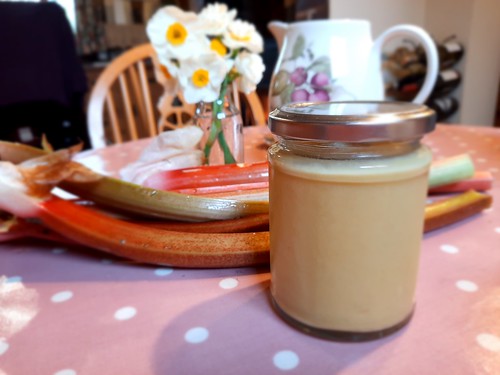We love a rhubarb crumble but when there is a glut, we need to be creative to make the most of this abundant springtime fruit (or is it a vegetable??). I have shared on here previously the recipe for rhubarb cordial (April 2023), a favourite of ours. As I often make lemon curd when we have an egg glut, I decided to adapt the recipe and method to make a delicious rhubarb curd.
Making this curd is not quick as, with any curd, slow is key. However, your patience and efforts are rewarded with a jar that combines the wonderful flavours of rhubarb and custard.
First, I stew 500 g of rhubarb (washed and chopped into chunks) with 2 tablespoons of caster sugar and 2 tablespoons of cold water. I let this simmer until the rhubarb is all cooked and rather mushy. I let this cool off the heat for a while before turning it into a thick puree.
To do that, I pour the rhubarb pulp into a sieve over a bowl or measuring jug and press it through with a wooden spoon. This process takes a while to obtain a thick puree with only a little fibrous rhubarb left over (you can add this to a crumble or a cake instead of discarding it). Sometimes I add red food colouring at this point to make the puree pinker but this is not essential. I don't add it if I think the puree is a little too runny as drops of extra liquid at this point will not help the curd thicken. The thickness of the puree is directly related to how much water your rhubarb stalks held, which depends on the variety of the fruit but also when it is harvested. So it is not an exact science and the weight of the rhubarb used may need adjusting.
I then pour a little water into a saucepan on top of which I place a heatproof bowl, ensuring the bottom of it does not come into contact with the water. In the bowl, I put 80 g of unsalted butter (cubed), 130 g of caster sugar, 3 large eggs (beaten well and strained to ensure a they are smooth) and the rhubarb puree you have just made. Turn the heat on and bring the water to a simmer whilst continually stirring all the ingredients in the bowl. Turn the heat down to obtain a constant, low simmer whilst you keep stirring. Steam is doing the cooking here and that needs to happen very gently and slowly to avoid scrambling the eggs!
The mixture needs time to cook and thicken, likely around 20 minutes but it can take longer depending on your set up. The right consistency is that of a thick, smooth custard that coats the back of a spoon: you want gloopy, not runny!
When the curd is cooked, I pour it into hot, sterilised jars and lids. The contents have not really been pasteurised so shelf life for this rhubarb curd is limited. It needs to be stored in the fridge and when opened, a jar should be eaten within a week or so (don't hold me to that as it all depends on the cooking and sterilising method you use).
You won't have any trouble getting through the jar as this creamy curd is delicious on toast, crumpets, scones and pancakes and also in cakes as a tangy layer in a victorian sandwich for example. Enjoy!
